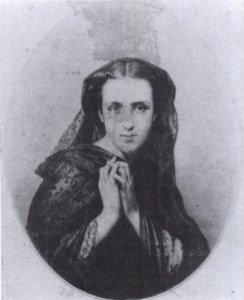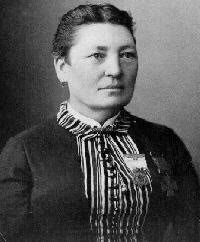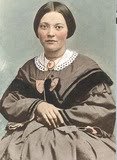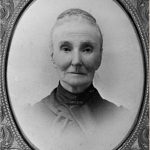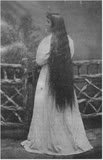Battle of Spotsylvania Court House
On May 7, 1864, after two days of brutal fighting failed to produce a victory at The Wilderness, previous Union commanders would have chosen to withdraw behind the Rappahannock River. But General Ulysses S. Grant ordered General George Meade to move around Lee’s right flank and seize the important crossroads at Spotsylvania Court House to the southeast.
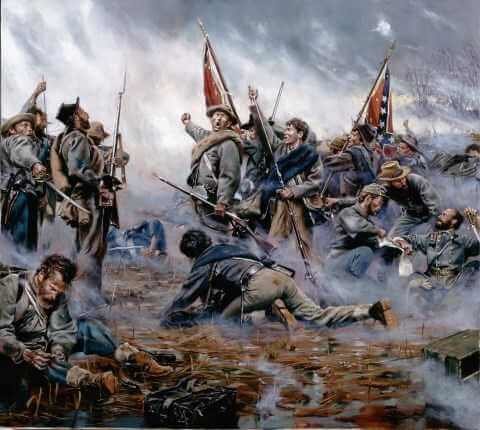
Image: Bonnie Blue Flag by Don Troiani
Mule Shoe, Spotsylvania Court House, May 12, 1864
With Federals pouring over the entrenchments, Confederate formations are in disarray. To encourage his comrades, Private Tisdale Stepp of the 14th North Carolina begins singing the stirring Southern anthem Bonnie Blue Flag and others soon join him.
Elements of General Robert E. Lee‘s army beat the Unionists to the crossroads town and began to entrench, and the two armies dug in for two weeks of trench warfare along six miles of earthworks. Fighting continued at Spotsylvania Court House off and on from May 8 through May 21, 1864.
Witness to War: Katherine Couse
William and Elizabeth Couse and their seven children moved to Laurel Hill from New Jersey in 1840. With a successful sawmill and more than 1,400 acres of land, the family prospered. In May 1864, Katherine, one of the Couse children, was living at Laurel Hill, north and slightly west of the battlefield. Originally from New Jersey, the Couse family supported the Union, unlike most of their neighbors.
Katherine wrote a letter to an unknown relative over a period of 18 days, describing her experiences as the battle raged nearby. Couse was an excellent writer, but I have changed a few spelling and grammar errors to improve readability. Though she was too far away to see the actual fighting, her home and its grounds were used as field hospitals. These excerpts are Couse’s firsthand account of those early May days:
… Here we have suffered so much anguish of mind, I now feel that the last link is broken that binds me to the home of my childhood. I can stand the many privations and inconveniences with some degree of fortitude. If the South could be starved out, I would even willingly starve within an inch of my life – but my very soul rebels against the many other harassing annoyances we are subject to. …
There is no peace in living in this God forsaken country. It is fearful to see with what impunity all kinds of robbery and roguishness [sic] are carried on. Might makes right here, we wake up in the morning and find the thing we prize most highly gone. We are suffering from such lawless times as existed in the dark ages, but no knights errant rise up with the times to protect the helpless and redress grievances. We look over to the knights in Blue, and ask their protection. … We feel like prisoners.
Friday, 6th May
We hear many voices, heard the cannon the first thing; they jar the house continually, lovely morning, the whole outdoors alive with voices of soldiers, hear wagons and cannon moving, rumbling, Oh! so anxious. A rough Federal scouting party came up and acted very badly this morning. They took nearly all our little cows, and a good many fowls, all remonstrace was vain. …The cannon shake the very foundation of the house, two southern soldiers just now came, first one side then the other. Here we hear the shells whistling at a terrific rate. Oh, it makes me so weak so generally wretched, heard the Southern bugles, we are surrounded – Yankees on one side Southern soldiers on the other. Pickets and videttes on all sides. … The Court House Road is alive with yelling soldiers, hear skirmishing at intervals all day up there. Charging sabres this eve late, yelling no firing.
Saturday 7th May
Calmer this morning, we are choked with smoke from camp fires and woods fire. Confederate scouts and soldiers riding through thick going down in the direction of Piney Branch towards the Yanks. Oscar started home this morn. Hear occasional cannon and guns crack away awhile then stop. The soldiers told me General Longstreet was wounded slightly in the top shoulder yesterday and that they drove the yankees all day. They also say Generals Wright and Battle were killed yesterday. …
Mule Shoe
On May 8, engineers on the staff of General Robert Lee arrived at the crossroads town of Spotsylvania Court House and began building an extensive network of earthworks in the shape of an arc that began at the Brock Road and was anchored south of the Court House. Working hurriedly, the engineers did not notice that they had made a serious error. As they followed the natural terrain, they left a large area that jutted out from the line of works in a horseshoe shape. The military called this bulge in a line of battle a salient; Confederate soldiers named it the Mule Shoe.
The disadvantage of a salient is that can be attacked on three sides, and it exposes the line of battle to fire from multiple directions. However, its defenders can also fire upon their attackers from all sides, and, at Spotsylvania, from almost impregnable positions. To give added protection to the soldiers who manned the salient, they constructed two lines of fortifications that ran at right angles to each other. The earthworks were then reinforced with timber and guarded by artillery placed to allow them to fire on any attacking force.
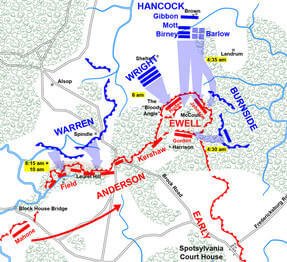 During the Battle of Spotsylvania Court House, the Union V Corps, commanded by General Gouverneur Warren, established its primary field hospital at Laurel Hill, Katherine Couse’s home. Soon the place was flooded with wounded, wagons, soldiers, and surgeons – in the yard, outbuildings and the house. When May 1864 began, the V corps included more than 25,000 men. When the battle at Spotsylvania ended, more than 10,000 were casualties.
During the Battle of Spotsylvania Court House, the Union V Corps, commanded by General Gouverneur Warren, established its primary field hospital at Laurel Hill, Katherine Couse’s home. Soon the place was flooded with wounded, wagons, soldiers, and surgeons – in the yard, outbuildings and the house. When May 1864 began, the V corps included more than 25,000 men. When the battle at Spotsylvania ended, more than 10,000 were casualties.
On May 12, General Ulysses S. Grant ordered General Winfield Scott Hancock and his 15,000 men to assault the Mule Shoe. He was initially successful, but the Confederates soon rallied and repulsed his attack. General Horatio Wright assaulted the western edge of the Mule Shoe, instigating hours of intense hand-to-hand fighting across the breastworks. General Ambrose Burnside and his men came on in support but did not improve the situation.
Katherine Couse’s reaction to the battle at the Mule Shoe:
Thursday 12th May
Old Mrs. Frazer and Mrs. Long have just come through the rain – coming for protection. I feel sorry for them. Oh! God there is now the most murderous battle raging, the continuous roar of cannons the still more terrific musketry sounds awful indeed. … the poor wounded heroes are now coming in ambulances, they stand with stretchers to remove them to the tents, on the amputations tables. I can see them lying stretched out ready to be operated on. Mr Forbes – the artist sketcher for Frank Leslie called in out of the rain, his right arm is helpless. He sketches with his left hand, has not the use of all his fingers on that hand … the house is perfectly muddy and hoggish, tracked all up, with refugees, children, dogs and soldiers. … 4 o’clock, the battle still raging. …
Bloody Angle
The combatants fought a seesaw battle across the same trenches in the Mule Shoe far into the night – using single shot muskets, the contending troops were periodically reduced to hand-to-hand combat. Survivors later attempted to describe the hellish intensity; they could not find the words. One Union officer wrote:
The horseshoe was a boiling, bubbling and hissing cauldron of death. Clubbed muskets, and bayonets were the modes of fighting for those who had used up their cartridges, and frenzy seemed to possess the yelling, demonic hordes on either side.
This insane combat continued into the night. At 2 o’clock May 13, orders reached the men in grey to fall back to a new line of fortifications at the base of the Mule Shoe. After 22 continuous hours of brutal combat and 17,000 casualties, a slight turn in the earthworks on the western edge of the Mule Shoe would become known to history as The Bloody Angle. With the early rays of dawn, Federal soldiers found the Bloody Angle inhabited only by those who could not withdraw:
They were lying literally in heaps, hideous to look at. The writhing of the wounded and dying who lay beneath the dead bodies moved the whole mass…
As the days passed, Katherine Couse continued writing her letter:
Sunday 15th May
The weather is still cloudy, showery, and unpleasant, the old stable is full of wounded – poor suffering mortals. We prepared some coffee, tea and fruit for them. It is soul sickening to look at the horrid suffering. One poor man says “Oh! the inhumanities of war.” Dr. Chambers eats with us and stays in the house.Monday 16th May
I have heard no musketry or cannon today, the first still day in a long long time. … There are a good many wounded here yet, they are prisoners. Rebel cavalry riding up any time. They moved Major Levitt and a Lieutenant into that little house in the corner of the yard [an outbuilding], it was full of wounded once. …This afternoon wagons with provisions for the federal wounded came in. … They commenced unloading, but concluded to remove the hospital. … Everything was hurry and all excitement. … They left us some sugar, coffee and fresh meat. The commissary promised to send for us each a calico dress. They left us weeping, sad and lonely… They all got off about dusk, then the stillness of death settled around us. Now all the air a solemn stillness holds. It seems as if some great funeral procession had lately passed through. …
Friday 20th May
Soldiers were riding and walking up all night long, rapping at the doors to inquire the way to their breastworks. I judge they must have been driven back though they always say they are the driving party. It is clear this morn but very wet. … It has been remarkably calm thus far to day. I have not heard a single gun or cannon. …
Grant’s troops did not begin their movement south from Spotsylvania Court House until the night of May 20–21. The Overland Campaign continued as Grant attempted to engage Lee, but was frustrated by strong defensive positions, always moving in the direction of Richmond. The two generals fought major battles at the North Anna River and Cold Harbor. Grant then crossed the James River and the armies took positions in front of Petersurg, where they faced each other during a siege of nine months.
Landrum House
When the war began, Edward Landrum lived north of Spotsylvania Court House with his parents, Willis and Lucy, and his three siblings Bettie, Cornelius, and Lucy. The Landrum house stood about 800 yards northeast of the Mule Shoe, and their 170-acre farm comprised much of the area covered by the Union advance on May 12, 1864. The house was General Hancock’s headquarters at least part of the day. The house suffered severely – it was virtually uninhabitable afterwards.
On the evening of May 11 the Confederates had removed their artillery from the Mule Shoe under the mistaken impression that Grant was leaving Spotsylvania.
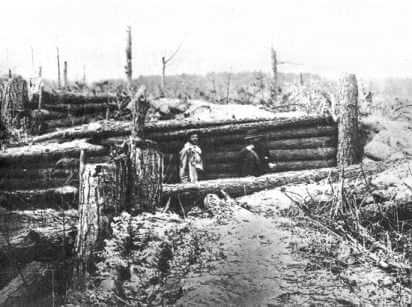 Image: Elaborate Confederate defenses at the Mule Shoe
Image: Elaborate Confederate defenses at the Mule Shoe
Confederate defenses consisted of logs and earth with a ditch behind. In many areas, logs and earth also ran at right angles to the main line creating what one veteran described as rooms.
At 4:30 a.m. on May 12, General Winfield Scott Hancock’s 15,000 men crossed the fog-shrouded Landrum farm with fixed bayonets. As they reached the earthworks, Confederate artillerymen were moving their cannons back in position in the Mule Shoe. With everything in disarray, the Federals captured about twenty guns. The mist dampened the powder in their guns and prevented many Confederate infantrymen from firing a shot. Hancock’s soldiers quickly took a half mile of fortifications and almost 3000 Rebels as their prisoners.
15,000 men of the Union II Corps under advanced with bayonets fixed across a fog-shrouded field on the Landrum farm – just when the Confederates were moving their cannons back to their original positions. About twenty guns were captured – some without firing a shot. A few Confederate infantrymen tried to shoot, but damp powder from the mist prevented many guns from firing. In a short time, Hancock held a half mile of the Confederate trench line and took nearly 3,000 prisoners.
However, by 9:30 a.m. the Southerners had recaptured most of their original line. Then the Union VI Corps arrived on the scene. During the following eighteen hours, the fighting was concentrated at a slight bend in the earthworks on the west side of the Mule Shoe, known to history as the Bloody Angle.
Union soldiers had discovered that a shallow valley near the Confederate line provided shelter for dozens of men, and they took advantage of it. Throughout the day, Federals left the concealment of the forest and quickly crossed the road that led to the Landrum House, and hid in the swale in the land. From there they kept up constant rifle fire and periodically attacked the breastworks, where the fighting was up-close and personal.
A North Carolinian, who had fought almost continuously during that 22-hour marathon of hand-to-hand combat at the Mule Shoe, later remarked:
I never expect to be fully believed when I tell of the horrors of Spotsylvania. The battle of Thursday [May 12] was one of the bloodiest that ever dyed God’s footstool with human gore.
In 1895, journalist J.H. Beadle visited the battlefield at Spotsylvania. He interviewed Edward Landrum, who was thirteen at the time of the battle and still lived there. The Landrum family had sensed battle was imminent and “ran down to the Court House.”
Our house was first taken for a Confederate hospital, and when the Confederates fell back and the Federals came on the whole place was swept clean. All the horses were run off or killed, and a big herd of cattle were killed and everything else in the livestock line. Our house was shot all to pieces, and the furniture destroyed and the fragments taken to build breastworks, but the strangest thing was about the feather beds.
When my sister and I came back, we walked along the breastworks, and she saw a piece of the ticking sticking out, so we went to work and dug and pulled and got every one of our seven feather beds out of the breastworks. What the Yankees put them in for I can’t imagine, but right along there, although it wasn’t the hardest fighting, you could walk 100 yards or so on dead bodies. This pine thicket was then an open field, but it has grown up thick since. All this field was a graveyard. The first years I worked the farm I plowed up six skeletons.
McCoull House
In May 1864, farmer Neil McCoull and his unmarried sisters – Mary, Eliza, and Milly – lived in a modest house on a farm of a few hundred acres near Spotsylvania Court House. Around the house stood a kitchen and other outbuildings. They lived quiet lives and made a humble living raising grain, but their lives would soon be changed forever. Dirt farm lanes ran between the McCoulls and their neighbors the Harrisons to the south and the Landrums to the north.
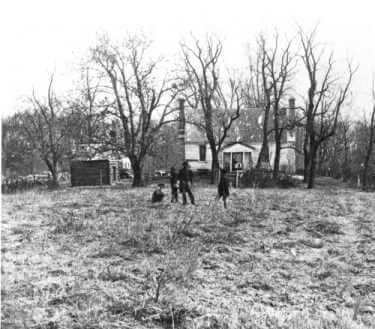 Image: McCoull House
Image: McCoull House
Spotsylvania Court House, Virginia
On May 12, Federals began attacking the earthworks surrounding the Mule Shoe and the McCoull house was caught in the crossfire of repeated attacks and counterattacks. Neil McCoull was not at home at the time; his three sisters escaped the deadly missiles by hiding in the cellar. When Hancock’s Union troops broke through at the Mule Shoe, they almost reached the McCoull House. When the Confederates fell back to an interior set of earthworks on May 13, they left the McCoulls’ house riddled with bullets and their fields littered with bodies.
Postwar burial crews unearthed 1,492 bodies of slain soldiers buried on the McCoull farm during the battle, probably more than any other single property in the United States. A newspaper advertisement from 1892 listed the McCoull farm for sale:
This place has been rendered famous by reason of having been the ground upon which one of the fiercest and bloodiest battles of the war was fought. It is now known by no other name than the Bloody Angle, bearing endless reminiscences of the great battle; being visited by all tourists who feel an interest in viewing the scene of battle. Large trees were by the Minie balls shot [off] as if cut or sawed off… This will ever be a famous field living in history as the field upon which conspicuous acts of gallantry evinced to the world that for courage the American soldier stands unexcelled. …
The fighting at Spotsylvania Court House, with so much loss of human life, frustrated Union leaders, and Lee’s skillful generalship had denied Grant the decisive victory he sought there. However, the North’s constant hammering away at dwindling Confederate resources at North Anna, Cold Harbor and Petersburg, would eventually drive the Confederacy into oblivion.
SOURCES
Battlefield Landmark for Sale
Battle of Spotsylvania, Virginia
Wikipedia: Battle of Spotsylvania Court House
Bedsteads and bones: a walk at the Bloody Angle with E. L. Landrum
Echoes from the Bloody Angle: a real-time description from Katherine Couse’s Laurel Hill


